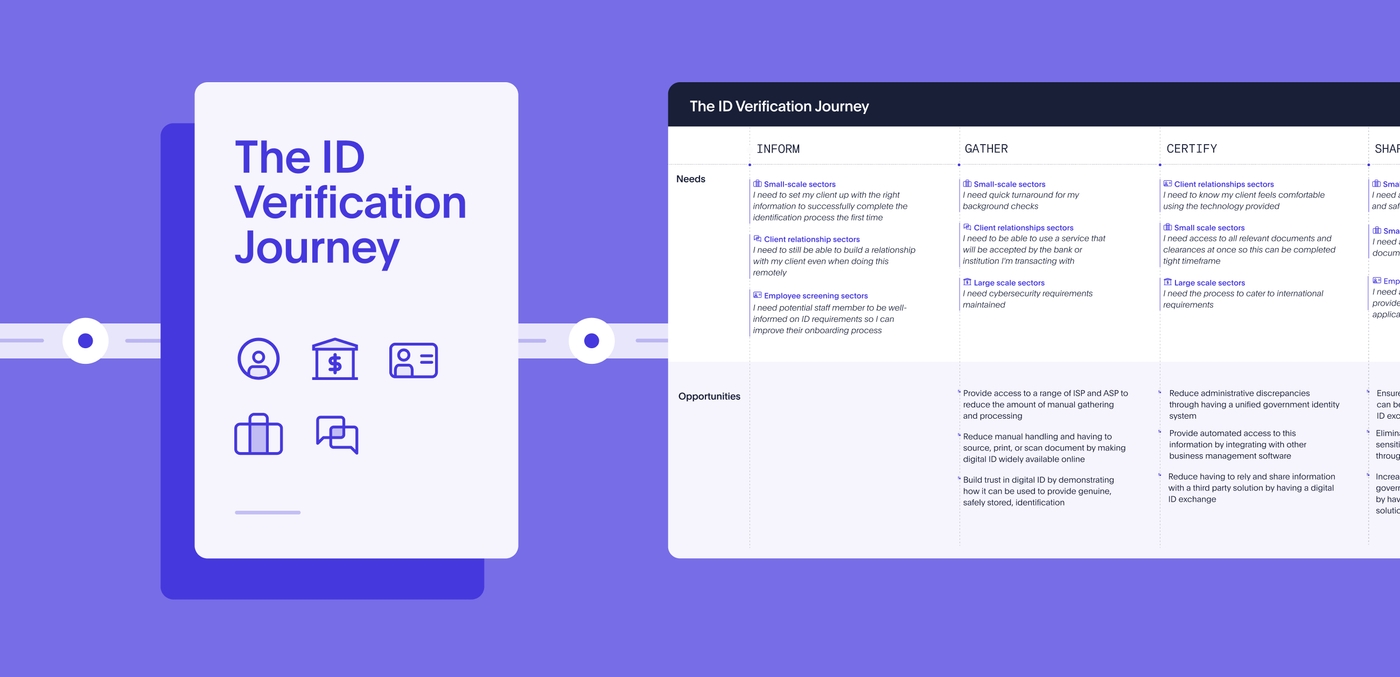The DTA selected Portable to deliver an evidence-based Discovery Report, providing a detailed summary of our user research and engagement across a variety of private-sector industries with respect to understanding the potential use of Digital Identity.
The DTA’s Digital Identity program (digital ID) provides Australians and businesses with a single, secure way to access government and other services online. The Digital Identity system includes everything from the policy and processes governing the system, to the technology and systems that allow it to work. Digital ID is committed to expanding into a whole-of-economy Digital Identity system encompassing state, territory, and private sector services.
We worked with the DTA to understand which areas of the private sector would benefit most from digital ID rollout and identity opportunities. To accomplish this, we conducted 15 interviews with professionals from 8 different sectors to gain an in-depth look at private sector experiences with digital identity systems, including drivers, needs, pain points, and barriers to inform the future state of digital identity.
Approach
For this private sector initial discovery, we took an iterative design research approach, where insights from DTA’s prior research and subject matter expertise shaped the approach to private-sector research. The insights from this research were then validated with members of the DTA digital ID team, which informed the key opportunities and prioritisation of private sectors. We used a broad exploratory style of qualitative research that sought to understand a range of sectors in order to identify where opportunities lay across the whole of the private sector. A key aspect of delivering this project was the collaboration between our Design Strategists and Business Analysts. The role of a BA on this project was to provide focus through a technical lens, while also supporting the strategists through the research process.
Our approach also aligned directly with the DTA digital service standards and the 13 criteria categories which aim to standardise the way in which new services are designed and delivered.
Iterative Design Research
We began by collating and conducting Desktop Research so that we could get a better understanding of the current digital identity landscape. This allowed us to move seamlessly into User Interviews, where we spoke to subject matter experts across a range of industries such as Finance, Banking and Utilities.
In our interviews we sought to understand:
- A thorough understanding of user and private sector needs
- Existing business processes associated with the service and possibility of implementing digital identity by using technical requirements gathering
- Frameworks that support business processes that are currently in use or will be needed when implementing digital identity, e.g. privacy and security concerns
- Any obvious technical, legislative or other drivers relating to the possibility of implementing digital identity in the private sector
- Insights into the current state of private sector industries technology and processes
- Opportunities for DTA to explore the private sector further.
The value of the research we did was being able to determine the differences and motivations of each industry and map them to a visual representation of each sector to determine the priorities for a digital identity rollout through market segmentation.
Stakeholder engagement
Collaboration and input from the DTA were key when synthesising the data. We ran two workshops with different DTA teams. The first was a Technical Workshop, and the second was an Insights Gathering Workshop. Both workshops elevated our research and understanding enabling us to create a well developed Journey Map that highlighted the opportunities for digital identity in the private sector industries we spoke to.
Final report
The discovery report gave an overview of the research process including:
- Our approach and research methods used
- Private sector overview & ID verification user journeys
- Current perceptions of government
- Private sector needs & opportunities
- Prioritised sector recommendations and next steps
The report provided:
- A recommended prioritised list of private sector industries with justification for why these have been prioritised and identification of whether these industries will fit into the Digital Identity system as either Identity Service Providers, Attribute Service Providers or Relying parties.
- A consideration of user experience and privacy
- Identification of opportunities for further research and expansion of digital identity

Final Presentation
Our project deliverables included a final showcase alongside other digital identity research packages of work to the DTA, Services Australia and the ATO. The showcase highlighted the research undertaken and our identified opportunities for DTA.
Outcomes
The research report delivered to the DTA highlights the various identification user journeys those in the private sector take, highlighting opportunities and challenges for DTA to explore.
The report also outlines the current perceptions of government within the private sector that was found during our research. Outlining those perceptions, provides a unique opportunity for DTA. If those perceptions are addressed and changed, the opportunities in the digital identity landscape widen dramatically.
One of the key benefits of this project was the client and stakeholder buy-in. The DTA are willing to invest and collaborate on these solutions which will be key to the eventual success of the product.
We visualised the research by creating a detailed journey map, which helped bring it to life and make it more accessible.
Portable's project team
Olivia Gregory, Digital Producer
Belinda Donald, Senior Design Strategist
Luke Thomas, Senior Design Strategist
Greg Corlett, Senior Business Analyst
Jackie Garfield, Senior Experience Designer